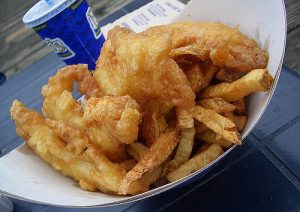With an abundance of local marine life within arm’s reach, Vancouver has endless seafood options varying from Pajos fish and chips to fresh oysters at the Blue Water Cafe! While enjoying this variety of seafood, have you ever wondered how these fish end up on your dinner plate?
Different fishing gear types are used depending on the size, weight, and location of the fish that is being caught. Although all gear types impact the ocean to some extent, the degree of impact varies!

Image of Pajos fish and chips at the Steveston wharf. Image: are you gonna eat that
Uncovering the impacts
To learn about the global use of fishing gear types and its associated consequences, we reached out to Tim Cashion – a research assistant at The Sea Around Us research initiative at the University of British Columbia.
The Sea Around Us research initiative previously reconstructed global annual catches; however, it did not account for small-scale fishing (fishing for survival) and discarding (unwanted catches thrown back into the ocean). Cashion and his team utilized this prior work as well as analysis of more recent fisheries annual reports to reconstruct a database that accounts for all global marine catches, including: industrial fishing (fishing for profit), small-scale fishing, landings (catches of fish brought back to ports), and discards.
The most common gear types
Bottom trawling – the most destructive but widely used industrial gear type -involves dragging a large net across the ocean floor. The nets are held open by steel poles which detach coral from the ocean floor. This is detrimental to fish because corals serve as essential habitats for spawning and protection from predators.
Conversely, purse seining involves setting a purse-like net into the ocean and pulling it closed to trap schools of fish! This method is less destructive and more effective as it catches up to 99% of the species that the gear is intended to catch.
A video of common fishing gear types used in small-scale and industrial fisheries:
Video: wonderfulblossoms
Unintentional catch
Although fishing gears are skillfully constructed, they are not perfectly selective! For instance, bottom trawl nets catch every life form that it encounters. Consequently, fish of the wrong species are often caught and thrown back into the ocean in their dying state. If these perfectly good fish entered the market then the price of fish would be cheaper! Who doesn’t like to save money?

Image of a sea turtle entangled in a net. Image: Doug Helton
Importance of the reconstructed database
The reconstructed database allows fisheries scientists to evaluate the risk of overexploitation of some species. Furthermore, this information will help improve fisheries management and ensure that fish populations do not decline overtime due to fishing practices.
A podcast discussing the major impacts of fishing gear types is linked below.
By: Jack Bae, Sami Ko, Alex Ponomarev, and Jodie Xie

